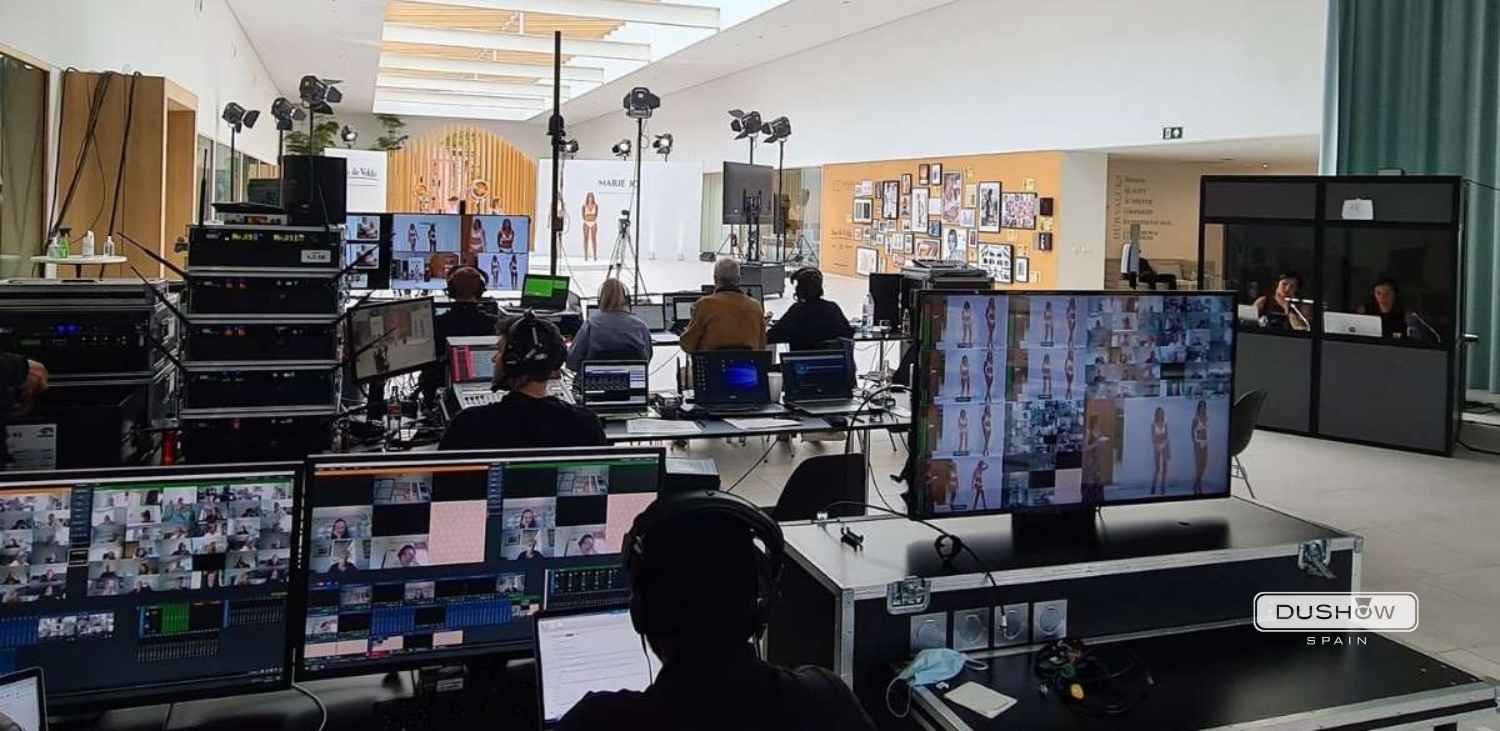Dushow Spain is now Novelty Spain
Livestream event: What it is, how it works and the tips you need to do it
Livestreaming, the on-line broadcasting of events, has opened infinite possibilities for the event world. Conferences, concerts, product launches and other major events have been moved by their organizers into digital formats to get all the benefits of streaming.
Livestreaming for events has only become more relevant with the rise of hybrid and virtual events in recent years. However, to produce live, professional-quality streaming, you’ll need more than a webcam and a YouTube channel.
This article will show you how livestreaming can work at events, how to create your strategy and the essential audiovisual equipment you’ll need, in addition to the tools that will help you stream remotely and reach your audience through hybrid and virtual events.
The Power of Livestream Events
There are three different ways to stream your events, and for people in remote locations to attend them.
- In real time: If you want your remote attendees to be able to ask questions, contribute their opinions or ideas to bring them closer to your brand, and take an active role in the event, real-time streaming, better known as livestreaming, is the best alternative.
- With a few minutes’ delay: If you need to modify or edit content as you broadcast the event, you can do so with more latency, which means that the video is broadcast with a few minutes’ delay.
- Simu-live: Another option is to tape the event and make it available for on-demand viewing at a later time, in the format known as video on-demand (VOD).
This article focuses on live broadcasting, also known as livestreaming.
Streaming events is an excellent way to humanize a brand, develop its authenticity, generate trust and get closer to your audience. What’s more, live content spectators will feel more up to date, informed and involved than they would watching a previously-recorded video of the event.
Create your strategy: 5 key questions
Regardless of your knowledge about livestreaming of events, you should make sure that your content strategy has been built to hold a live event. In other words, while Video On Demand (VOD) gives you the luxury of post-production to polish the final product, livestreaming happens on the go; there is no time for editing. This means you’ll need in-depth preparation and a lot of testing prior to the event.
That is why it is so important to know the answers to five key questions you should ask before taking steps to livestream your event:
1. What’s your content strategy?
Content is king when it comes to producing a livestream. It will define all the other parts of your event. What are you going to broadcast live? Who will be your audience? Bear in mind that, depending on the type of event you’re holding, your content will impact several other technical details such as lighting, the type of cameras you’ll need, sound and many other technical decisions.
Here are four essential factors to consider when planning the content of your event:
- Interest: make sure that the content of your event is aligned with the interests of your target audience and brand.
- Expectation: plan interesting, ongoing content to keep your live audience engaged. For example, consider using elements of virtual or augmented reality.
- Coherence: the event must be aligned with your brand’s past and future runnings. That way you assure generation of brand awareness and engagement with your audience.
- Call to action: facilitate attendees’ continued interaction once the livestream event is over. What is your call to action:?
2. Where do you want your content to be?
You can offer your livestream event on your company’s social media accounts, through a livestreaming platform or embedded on your website. Your choice will depend on how your audience acts, and where you want to offer your event.
For example, if it’s a private event, the best choice will be to offer encrypted content over your web portal. On the other hand, if it’s a public event, the more attendees, the better. In that case, it’s best to offer the livestream of your event on a number of different platforms.
3. Will the quality of livestreaming be the same as that of the physical experience?
If you’re streaming a face-to-face event, you should make sure that your on-line audience has the best possible quality and experience without undermining or interfering with the experience of your on-site attendees.
To make sure on-site delegates have a positive experience, plan ahead and do some tests in the run-up to the event. That way, you’ll ensure that everything works perfectly, that you have all of the necessary audiovisual assets and that the professional crew is up to speed on what to do at all times.
If you still have questions about choosing an audiovisual partner for your next event, here’s a video that can give you further guidance:
4. Have you set aside time to test your event’s livestreaming?
When it comes to livestreaming, there’s no end to the rehearsals and advance testing you can do. To prevent any snags during your event, the best thing you can do is to test, examine and previously evaluate all the equipment, processes and phases of the event. You should set time aside to check all of these things, and make sure that the on-site and the livestreaming parts of the event all work properly.
5. Are you fully prepared?
Preparation is one of the most essential principles of organizing any type of event. You should leave nothing to chance. You must be prepared at all times for any unexpected developments that may arise.
That’s why it’s so important to identify what might fail beforehand, to prevent and above all, be prepared to take action if necessary.
Four basic requisites for livestreaming of events
Once you’ve answered all those questions, it’s time to get to work on livestreaming your event. Here are the four basic requisites you’ll need to meet:
Internet connectivity
One of the best practices to put in play when designing the livestreaming of your event is to have a dedicated, reliable Internet connection. A bit of advice: we recommend you have double the upload speed that you’ll actually need for your event. That way, you’ll ensure that the connection will never crash while you’re streaming your event.
Switcher and encoder
This step is what differentiates a pre-recorded video from a livestream. An encoder is a piece of hardware or software used to turn a live broadcast or pre-taped video into a format that makes it visible on the Internet for viewers with personal computers or mobile devices.
A production switcher gives you the ability to mix shots from different cameras during the livestreaming of the event. It’s necessary for multi-camera productions.
Your venue: ready for action
Make sure you have access to the physical and digital event venue. Check in advance on items such as access infrastructure, loading and unloading permits for audiovisual equipment, safety regulations, etc. Then make sure you leave everything ready for the running of the event.
If you have a clear understanding of these details and are prepared for them, you’ll be ready to hold a successful livestreaming event.
Audiovisual equipment: What do you need?
Here is a list of the audiovisual equipment you’ll need for livestreaming your events. You can use it as a reference, but remember that no two events are alike. Therefore, certain elements may vary depending on the size of the event, your budget and many other factors.
- Cameras: professional cameras are of the utmost importance in livestreaming, as they ensure good quality and experience for the remote audience. They play a fundamental role! Remember, they film and broadcast the message behind your event. If you have three or more, you will also need expert, professional hardware to manage them.
- Sound: You will definitely want your message to be heard loud and clear. To make sure that happens, it’s a good idea to use cordless or lapel microphones. This should be in addition to speakers and, of course, a sound desk to reach the highest-quality audio.
- Lighting: The amount of lights and lamps may vary, depending on the size of your event. Remember, lighting is a key element that will bring quality, depth and warmth to the broadcast for the on-site audience as well as livestreaming users. what’s more, it will help you create the atmosphere and the effects best-suited to your livestream event.
- Streaming platform: there are a number of factors to bear in mind when evaluating streaming platforms, including reliability, personalization, privacy, security and distribution tools.
It may not seem important, but remember that having a proper work space for the technicians and production team is also high on the list of priorities. Having a well-designed control space is the first step for successful streaming of your event.
We hope this article has been useful to you, and brought you the tips and information on key factors you’ll need for your next event. If you cover all of these details when streaming your event, success is a given!
If you've enjoyed this article and found it useful, make sure to subscribe to our channel and visit our blog to not miss out on any essential content on the technical production and organization of virtual, hybrid and face-to-face events.
This article was first published in Dushow Spain, you can read the original Spanish version here.





